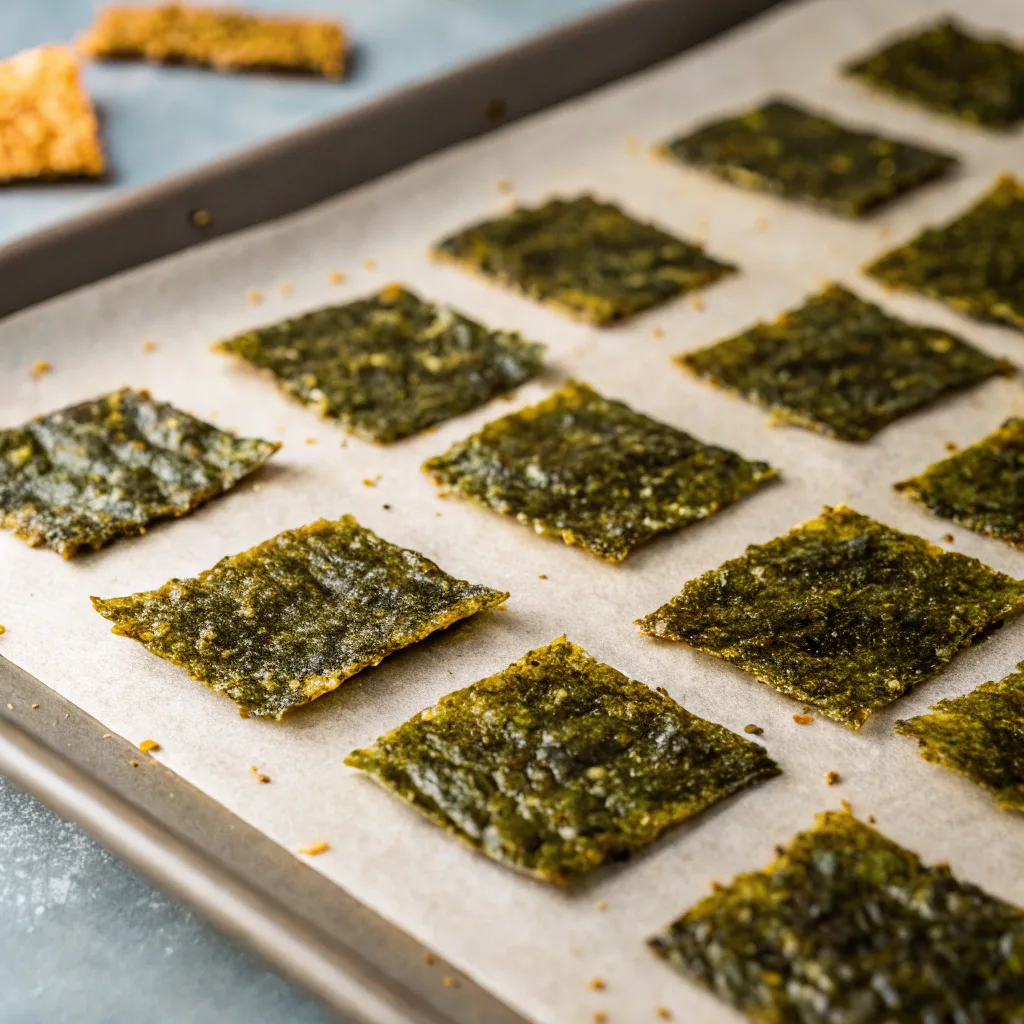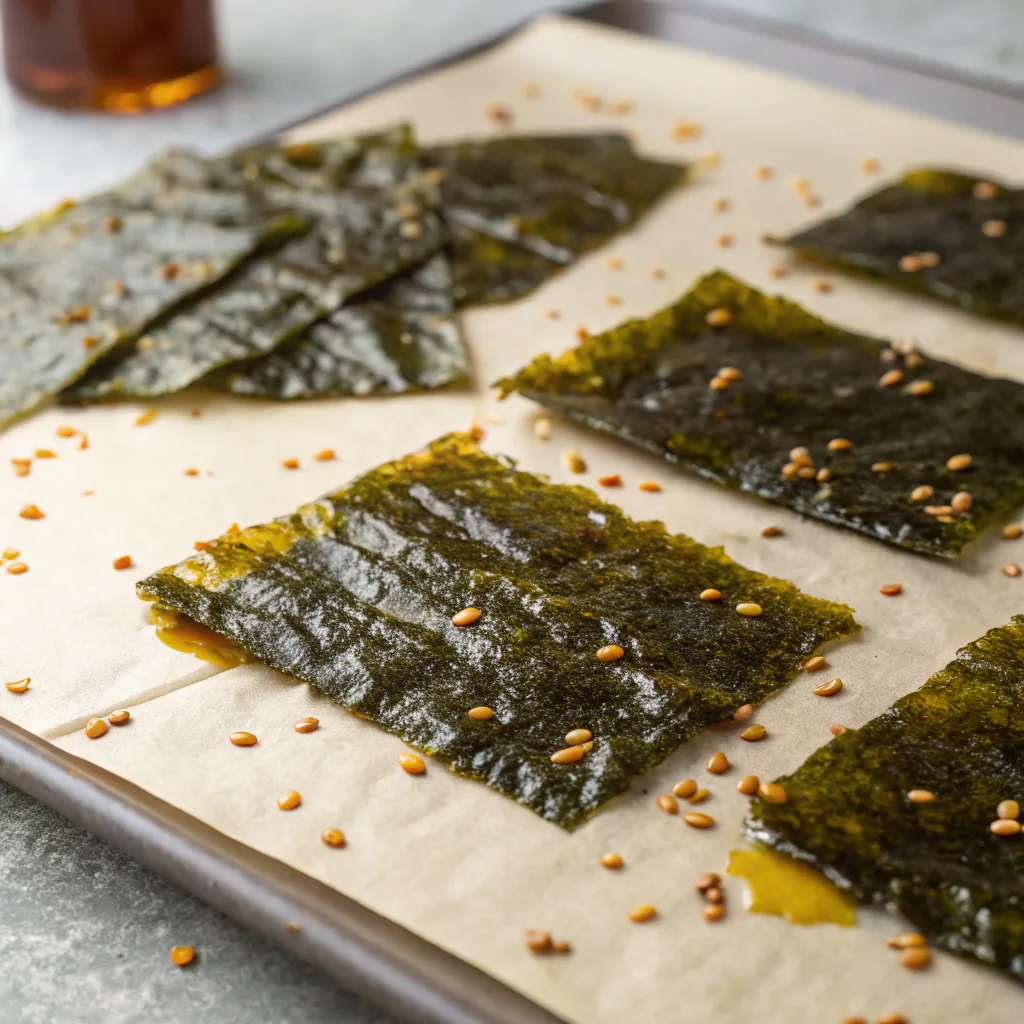Crispy Roasted Seaweed: Easy & Delicious
Have you noticed the growing popularity of Crispy Roasted Seaweed ? From grocery store aisles to trendy restaurants, this once niche food is making a big splash. Moreover, roasted seaweed, in particular, is gaining traction as a delicious, healthy, and incredibly easy snack. This article will guide you through everything you need to know about making perfect, crispy roasted seaweed at home. We will delve into the nutritional benefits, explore different seaweed types, and provide step-by-step instructions, along with creative flavor ideas, making it a simple and enjoyable culinary adventure for you. It is also a great way to incorporate more plant-based foods into your diet.

Table of Contents
What is Roasted Seaweed?
Firstly, let’s define what we mean by “roasted seaweed.” Unlike raw seaweed, which can be tough or slimy, roasted seaweed undergoes a process that transforms it into a light, crispy snack. Generally, this process involves lightly oiling and baking seaweed sheets until they become brittle and flavorful. This simple act of roasting changes the texture and enhances its natural flavor, making it more palatable. Therefore, it is a favorite among those seeking healthy, low-calorie snacks.
There are several types of seaweed commonly used for roasting, each with its unique characteristics:
- Nori: Most notably, nori is perhaps the most prevalent type, known for its use in sushi. It typically has a thin, papery texture and a mild, slightly salty flavor. Also, it’s widely available and easy to work with.
- Kelp: Kelp sheets are usually thicker than nori and offer a slightly more robust and “sea-like” taste. Furthermore, it contains a variety of minerals and is ideal for those seeking more nutrients.
- Dulse: Dulse has a reddish hue and a softer texture and provides a unique, nutty flavor, making it a nice change from more common varieties. It can be used for roasting, but it can take a little more attention.
The tradition of consuming seaweed dates back centuries in East Asian cultures, where it has been a staple food. However, it has only gained popularity in Western countries as a convenient and healthy snack option in recent years. This evolution from a regional staple to a global snack food illustrates its versatility and appeal. Finally, Understanding the different grades of textures available will also help you choose the right type for your roasting project.
Nutritional Powerhouse: The Health Benefits of Easy Roasted Seaweed
Roasted seaweed isn’t just delicious; it’s also a nutritional powerhouse. Moreover, it is packed with essential vitamins and minerals that contribute to overall well-being.
- Iodine: This is an essential mineral that plays a crucial role in thyroid function. However, it’s important to consume seaweed in moderation as it is high in iodine.
- Vitamins: Roasted seaweed is a good source of vitamins A, C, K, and various B vitamins, each playing a crucial role in bodily functions.
- Minerals: It’s rich in minerals such as calcium, iron, magnesium, and potassium, which are vital for bone health, energy production, and nerve function. In addition to that it also provides trace minerals like Manganese and Copper.
Furthermore, it is high in dietary fiber, which aids digestion and promotes gut health. Also, it boasts antioxidant properties that help combat free radicals and protect against cell damage, supporting your immune system. Additionally, roasted seaweed contains omega-3 fatty acids, which are beneficial for heart health. Importantly, it is low in calories and fat, making it an ideal snack for those watching their weight. Overall, it is a fantastic snack for kids and adults alike.
Therefore, considering its nutritional benefits, roasted seaweed is a great addition to a balanced diet. However, people with dietary restrictions, such as those watching their sodium intake or having seafood allergies, should be mindful of their consumption. In conclusion, understanding the nutritional makeup of roasted seaweed highlights why it has gained so much popularity.
The Easy Roasting Process: A Step-by-Step Guide to Crispy Seaweed
Making delicious, crispy roasted seaweed at home is surprisingly simple. Moreover, it requires just a few basic ingredients and minimal equipment. Here’s a step-by-step guide to help you achieve perfect results:
Equipment & Ingredients:
- Baking sheet
- Parchment paper or silicone baking mat
- Your seaweed of choice (Nori is the most common)
- 1-2 teaspoons of oil (sesame oil, olive oil, or avocado oil are good choices)
- Salt to taste
- Optional: other seasonings (garlic powder, sesame seeds, chili flakes)
Instructions:
- Preheat Oven: Firstly, preheat your oven to 300°F (150°C). A low temperature prevents burning, allowing the seaweed to dry out and crisp up evenly.
- Prepare Seaweed: Gently handle your nori or other seaweed sheets, keeping them intact. Cut the sheets into desired sizes if needed.
- Apply Oil & Seasoning: Lightly brush or spray each sheet with oil. It’s essential not to overdo it. A thin coating is sufficient. Then, sprinkle a pinch of salt and your chosen seasonings evenly over each sheet. This process ensures a balanced flavor.
- Roasting: Arrange the seasoned seaweed in a single layer on a baking sheet lined with parchment paper. Roast in the preheated oven for 5-10 minutes, or until the edges begin to curl and the seaweed is crispy. It’s essential to keep a close watch to prevent burning. The roasting time may vary based on your oven and the thickness of the seaweed sheets.
- Cooling: Carefully remove the baking sheet from the oven and allow the roasted seaweed to cool completely. During cooling, the seaweed will crisp up further.
- Storage: Once cooled, store the roasted seaweed in an airtight container at room temperature. To maintain its crispiness, avoid exposing it to moisture. Properly stored roasted seaweed can last for several days.

Following these detailed instructions, you will achieve crispy, flavorful roasted seaweed. Remember to keep a close eye on it in the oven and adjust cooking time accordingly.
Flavor Variations and Creative Twists for Your Roasted Seaweed
One of the best things about homemade roasted seaweed is the endless possibilities for flavor variations. Also, you can experiment with different seasonings and create unique tastes that cater to your preferences. For example:
Sweet Variations:
- Cinnamon Sugar: A sprinkle of cinnamon and a touch of sugar creates a warm, sweet treat.
- Maple Syrup: A light drizzle of maple syrup can add a subtle sweetness and caramel-like flavor.
- Coconut Flakes: Adding unsweetened coconut flakes during the last few minutes of roasting introduces a tropical element.
Savory Variations:
- Garlic and Parmesan: Sprinkle with garlic powder and grated parmesan for a cheesy, savory delight.
- Chili and Lime: A dash of chili powder and a squeeze of lime juice post-roasting adds a zesty kick.
- Everything Bagel Seasoning: This blend is perfect for a complex, flavorful taste.
- Soy Sauce/Tamari and Ginger: A light brushing of soy sauce or tamari mixed with grated ginger after roasting provides an umami-rich flavor.
- Furikake Seasoning: This is a Japanese seasoning mix that adds complexity and flavor.
- Spicy Blends: Consider combinations like cayenne pepper and gochugaru for a fiery taste.
Oil Variations:
- Infused Oils: Oils infused with garlic or chili offer a subtle yet distinct flavor.
- Nutty Oils: Oils like peanut or walnut provide a more intense nutty note.
Roasted seaweed can also be incorporated into a variety of dishes. For example, crush it and sprinkle it on salads, use it as a topping for rice bowls, or add it to soups. You can even layer sheets to make crispy seaweed chips or crackers. Pair roasted seaweed with dips like hummus or a creamy avocado spread for a complete snack experience. Finally, by experimenting with different textures, you can create variations from super crispy to slightly chewy to match your taste.

Troubleshooting and Common Mistakes When Roasting Seaweed
Even with the best intentions, things can sometimes go wrong. Therefore, knowing how to troubleshoot common issues can make your roasting experience smoother.
- Burnt Seaweed: This happens when the oven temperature is too high or the seaweed is roasted for too long. Therefore, always monitor the seaweed closely while roasting and adjust oven temperature as needed. Also, a lower temperature and shorter cooking time are often the solution.
- Uneven Roasting: This can occur if the seaweed sheets are not spread out evenly or if your oven has hot spots. Also, rotate your baking sheet halfway through roasting to ensure consistent results.
- Damp or Non-Crispy Seaweed: This usually indicates that the seaweed was not roasted long enough or that it has absorbed moisture post-roasting. Therefore, if this happens, you can place the seaweed back in the oven for a few minutes to re-crisp it. Make sure to store roasted seaweed in an airtight container.
- Uneven Seasoning Application: To ensure the seasonings stick effectively, make sure the seaweed is coated with a thin layer of oil or mist first.
Lastly, remember that every oven is different. Therefore, you may need to adjust the roasting time and temperature based on your experience.
Buying Guide: Choosing Quality Seaweed for Roasting
When buying seaweed for roasting, quality matters. Therefore, it is important to choose the right type.
- Source and Sustainability: Look for seaweed from reputable sources that practice sustainable harvesting methods.
- Organic Options: If possible, choose organic options to avoid pesticides and additives.
- Appearance: Choose sheets that are uniform in color and thickness, avoiding torn or damaged sheets.
- Label Check: Always read labels to check for added ingredients like excess sodium, artificial flavors or preservatives.
- Variety: Consider the intended purpose. Nori is most common, but other types like kelp and dulse will give different flavors.
You can find seaweed sheets in most Asian grocery stores, health food stores, or online. Buying in bulk may be a better economic choice depending on consumption patterns. In addition, keep in mind that proper storage of unroasted seaweed is as important as storage of roasted seaweed. Always store seaweed in airtight containers in a cool dry place to ensure its freshness. Therefore, investing in good quality seaweed will make a difference in flavor and health benefits.

FAQ: Your Questions Answered about Roasted Seaweed
Is roasted seaweed good for you?
Yes, roasted seaweed is very good for you! It’s packed with essential nutrients such as iodine, vitamins A, C, and K, and minerals like calcium and iron. Also, it is low in calories and fat, and high in fiber, making it a healthy snack option.
Why is Korean seaweed so expensive?
Korean seaweed, often prized for its high quality and delicate flavor, may be more expensive due to its specific harvesting and processing methods. In addition to that, production costs and shipping also contribute to its price. However, it is a premium product known for taste and quality.
What is roasted seaweed called?
Roasted seaweed is commonly known as “roasted seaweed,” but in some contexts, it may be referred to as gim (Korean) or nori (Japanese) if the specific type of seaweed is known. Also, you may sometimes see it listed as “seaweed snacks”.
Is roasted seaweed healthier than chips?
Generally, yes. Roasted seaweed is healthier than most potato chips. It is lower in calories, fat, and sodium while also being a great source of nutrients, vitamins, minerals, and fiber. Potato chips are usually high in calories, fat, and artificial additives, making roasted seaweed the superior choice for a healthier snack.
Conclusion
In conclusion, making your own roasted seaweed at home is incredibly easy and rewarding. Therefore, this versatile snack is not only delicious but also packed with numerous health benefits. By following our simple step-by-step guide, you can master the roasting process, experiment with a variety of flavors, and ensure a delicious and nutritious snack every time. This guide will empower you to make the perfect crispy roasted seaweed that is good for you and your family. So, start experimenting with your preferred flavors today, and enjoy the culinary possibilities of this simple yet powerful snack!
Cooking is an act of love and creativity! 🌟 What do you think of this recipe? I’d love to hear your thoughts and any tips or tweaks you’d suggest to make it even better. Let’s inspire each other in the kitchen!
There are no reviews yet. Be the first one to write one.






